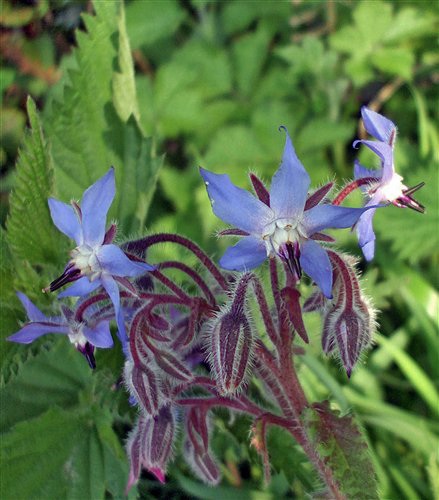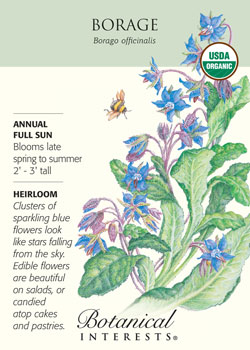One of my favorite early Spring flowers is Borage, Borago officinalis. Here in hot, humid south-central Texas, Borage is a plant that starts in early Spring. It doesn’t mind cool soil or air temperatures. It peaks with its bright blue, nodding flowers in late Spring and sometimes lasts until early Summer. Then, the heat causes it to wither. I also grow Borge in the fall. I start seedlings in mid September even though it’s usually still very hot. I keep them in the coolest place I can so once the seedlings are up and growing they have a chance to gain some size. Then, as the weather cools down in October, I plant my Borage in the herb garden and let it grow and flourish until our first frost.
If you garden where it’s not as hot as it is here in Texas, Borage will be a summer flower for you. You’ll be able to enjoy its benefits all summer long.
Growing Borage
Occasionally you might find Borage plants for sale at nurseries, but it is very easy to grow from seed. The seeds are large and easy to plant. Start the seeds indoors 8-10 weeks before your last frost or sow them outdoors around the time of your last frost. Find the date of the last frost in your area.
Borage can grow in full sun in most areas or part shade. I have found the plant will be more upright when grown in more sun. It will also flower more. It is not fussy about soil and takes average water.
The plant grows quite large and kind of floppy. So, after it blooms, don’t be afraid to cut it down- use the leaves for fertilizer as described below- and let the plant come back and bloom again.
Find Borage Seed at Botanical Interests. Just click on the seed pack, below.
Attract Pollinator & Beneficial Insects with Borage
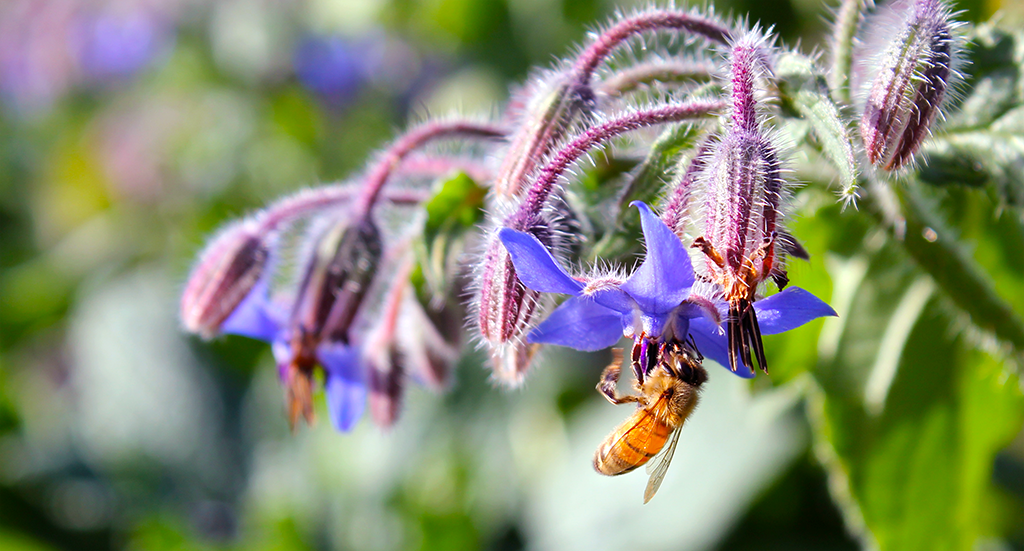
Borage is a welcome addition to the pollinator garden. The bright blue flowers stand out among the reds, oranges and yellows of other blooms. It is a bee magnet! It attracts other beneficial insects like green lacewings and parasitoid wasps. Planted around tomato plants it helps deter the moths that lay eggs that became tomato hornworms. I had a tomato hornworm attack on my white datura plant last year, so this year I’m planting Borage near my white datura.
A mature Borage plant can be large and sprawling, perfect for keeping the soil beneath it cool and inviting to harbor beneficial insects.
Borage Improves the Soil
Borage acts as a “nutrient accumulator”. A nutrient accumulator is a plant that sends down deep roots, often as a tap root. The nutrients are brought to the arial parts of the plant where the minerals are then stored in their leaves. The decaying leaves of these plants add those nutrients to the top of the soil where other plants can use them. Other examples of a nutrient accumulator is comfrey and yarrow.
You can either let the plant drop leaves as they die off or “chop and drop” them yourself using them as a nutritious mulch. To get the most out of the leaves, chop the plant down before it flowers keeping more of the nutrients in the leaves. If you grow Borage because you love to see the blue flowers and allow them to attract beneficial insects, chop your Borage down after it flowers. There will still be plenty of mineral rich goodness in the leaves to feed the soil. Adding the leaves to your compost is another way to utilize the nutrient accumulator power of Borage.
According to Louise Riotte, author of Carrots Love Tomatoes (1975), “Borage is an excellent provider of potassium, calcium, and other natural minerals of benefit to plants.”
Use Borage as Fertilizer
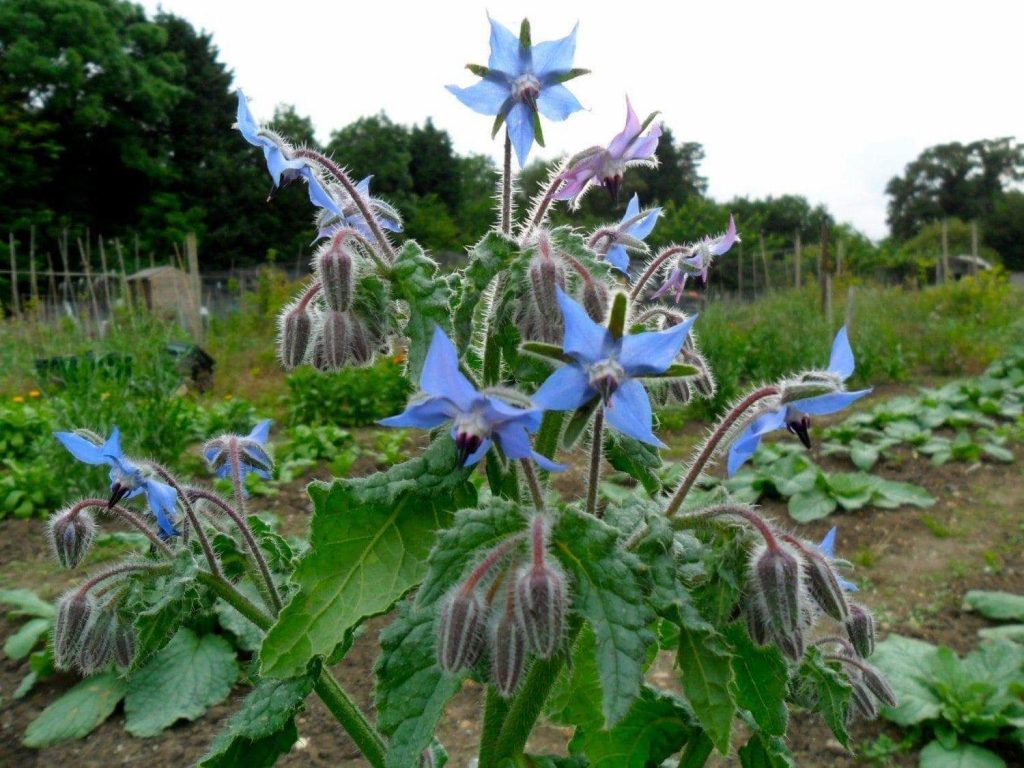
Yet another way to use Borage is to make fertilizer to feed potted plants as well as plants growing in the ground. Make sure you have enough Borage growing for this. Strip leaves off Borage plants and put them in a bucket. Add enough water to cover the leaves by a few inches. Cover and let steep for about 2 weeks. Then, strain the leaves out of the liquid. There you have it! Plant fertilizer. Mix 1 Part Borage Water with 10 Parts plain water and use it on all your plants. The undiluted solution should keep for a couple of months.
One caution- older Borage leaves and stems are hairy and coarse. It’s best to wear gloves if you’re spending some time handling the plant.
Borage in History
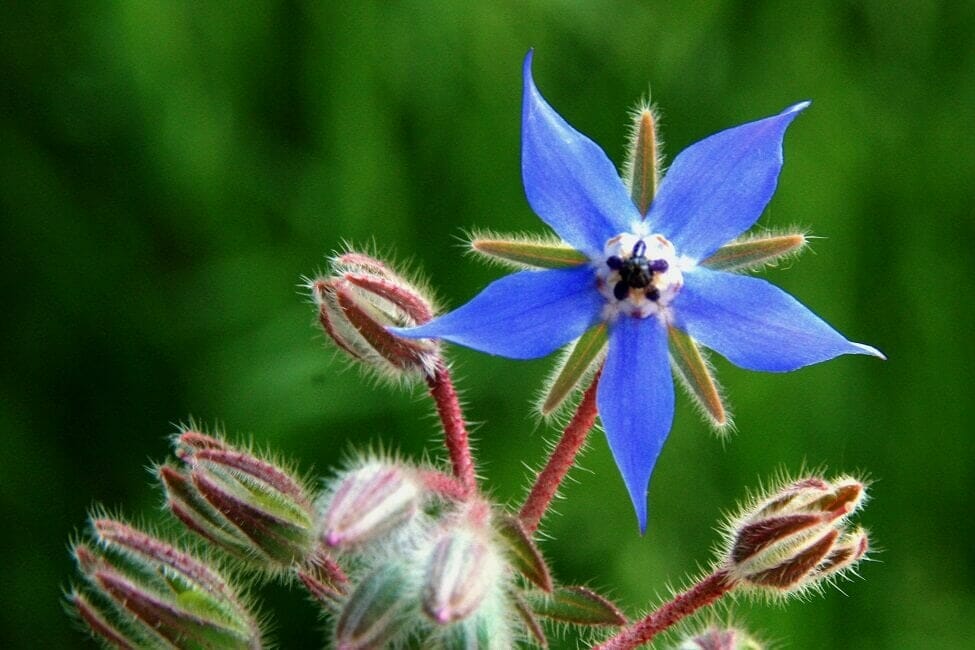
Borage is said to bring courage, dispell gloom and brighten one’s spirits. During the Middle Ages, women would embroider Borage leaves on scarves. The scarves were given to knights prior to a tournament or before going off to the Crusades. Young girls would serve Borage Tea to prospective suitors to encourage them to propose marriage. The plant was included in the gardens of Versailles during the reign of Louis XIV.
Recipe
Borage, with its rich blue flowers and large, coarse leaves is a stunning garden addition. It fills the space early in the season here before the weather gets too hot. Blue flowers are unusual enough that to me, Borage is very special. The flowers are edible, too! Just remove the hairy, dark anthers to reveal the bright blue corolla. It’s fun to freeze them in ice cubes to float in lemonade or iced tea. The young leaves and cleaned flowers can be eaten fresh in salads. They have a mild cucumber flavor and a cool aftertaste. Add the young chopped leaves to yogurt or sour cream for a dip.
Borage-Yogurt Dip
- 3 cup plain yogurt
- 1 clove garlic minced
- 3 Tbsp chopped young borage leaves
- 1 Tbsp chopped salad burnet (optional)
- 1 Tbsp chopped basil
Make a yogurt cheese: Line a sieve with a double thickness of cheesecloth, set over a bowl. Place yogurt in sieve and put sieve and bowl in refrigerator for at least 3 hours or overnight. Mix yogurt cheese with remaining ingredients in medium bowl. Refrigerate until ready to use.
Quote for the Month
Still round the corner there may wait, / a new road or a secret gate. -J.R.R. Tolkien, novelist and philologist (3 Jan 1892-1973)

